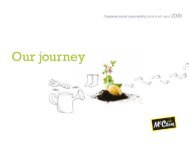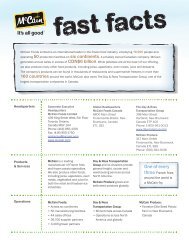From the Ground Up - McCain Foods Limited
From the Ground Up - McCain Foods Limited
From the Ground Up - McCain Foods Limited
You also want an ePaper? Increase the reach of your titles
YUMPU automatically turns print PDFs into web optimized ePapers that Google loves.
Cutter cannons.<br />
This approach depends on <strong>the</strong> contributions of <strong>the</strong> individuals who know <strong>the</strong> most<br />
about <strong>the</strong> area under review – <strong>the</strong> operators and managers who do <strong>the</strong> job every day.<br />
“This results in tremendous ownership for <strong>the</strong> identified improvements and fosters<br />
a culture of continuously reviewing and improving all aspects of <strong>the</strong> operation,” says<br />
Lloyd Borowski, global vice-president of engineering and manufacturing. “It’s all<br />
about continuous improvement, involving everyone – managers and operators alike<br />
– to eliminate unnecessary activities and costs throughout<br />
<strong>the</strong> system, to improve safety and quality, and to<br />
give customers 100 percent satisfaction.”<br />
In his 2006 webcast to <strong>McCain</strong> employees around <strong>the</strong><br />
world, CEO Dale Morrison said that MCE will improve<br />
safety, quality, and productivity, first in individual plants<br />
and <strong>the</strong>n across <strong>the</strong> entire organization. “It will make us<br />
a better company because it captures <strong>the</strong> imagination,<br />
energy, creativity, perspective, and ideas of our people.”<br />
As just one example of many, he pointed to <strong>the</strong> device<br />
developed by Ben Jenson, an employee at <strong>the</strong> O<strong>the</strong>llo,<br />
Washington, plant that helps operators test <strong>the</strong> jaws on packaging equipment to make<br />
<strong>the</strong> packaging process more efficient. To honour its inventor, <strong>the</strong> machine is called a<br />
Ben-dicator.<br />
Someone passing <strong>the</strong> parking lot of <strong>the</strong> Lamb Weston potato-processing plant in<br />
Weston, Oregon, in <strong>the</strong> late 1950s might have glimpsed an unusual sight: <strong>the</strong> owner<br />
of <strong>the</strong> plant, Gilbert Lamb, an engineer, shooting potatoes out of a fire hose. He was<br />
doing experiments that later developed into a device known as <strong>the</strong> Lamb Water Gun<br />
Knife, a major improvement over <strong>the</strong> simpler cutting devices that Lamb Weston,<br />
<strong>McCain</strong>, and o<strong>the</strong>r processors used when <strong>the</strong> industry was in its infancy.<br />
The water gun knife uses high-pressure water flow to launch raw potatoes at a<br />
speed of eighty kilometres an hour through a set of steel blades that can be arranged<br />
to produce different sizes and shapes of french fries. <strong>McCain</strong> licensed <strong>the</strong> technology<br />
from its competitor, Lamb Weston, on <strong>the</strong> understanding that <strong>McCain</strong> would share<br />
any improvements it made in it.<br />
The water gun, as originally designed, took strips out of <strong>the</strong> square centre of <strong>the</strong><br />
potato for french fries and slabs out of <strong>the</strong> side, which were sent directly to <strong>the</strong><br />
specialty product line. <strong>McCain</strong> wanted to increase <strong>the</strong> yield of fries from each potato.<br />
It did this by altering <strong>the</strong> gun to cut <strong>the</strong> entire potato into strips and <strong>the</strong>n using<br />
<strong>the</strong> strips unsuitable for fries for <strong>the</strong> specialty products. The water gun knife<br />
handles more volume than o<strong>the</strong>r cutting devices. Most<br />
important, it increases yield by cutting a straight line<br />
through <strong>the</strong> longest axis of <strong>the</strong> potato, <strong>the</strong>reby getting<br />
<strong>the</strong> longest possible finished product out of it. In o<strong>the</strong>r<br />
words, <strong>the</strong> water gun knife makes <strong>the</strong> average potato<br />
more valuable.<br />
Customers expect <strong>the</strong> cones of french fries <strong>the</strong>y buy<br />
in fast food restaurants to be full. “The longer <strong>the</strong> french<br />
fry, <strong>the</strong> less weight it takes to fill <strong>the</strong> container,” explains<br />
Morris. If it is filled with shorter fries, four to five centimetres<br />
long, it will weigh as much or more than one<br />
filled with nine-centimetre-long fries, but it won’t look<br />
as full. That’s why long fries have become <strong>the</strong> norm in<br />
<strong>the</strong> quick-service restaurant industry. “Fast food is sold<br />
on <strong>the</strong> basis of appearance ra<strong>the</strong>r than weight, and that<br />
is <strong>the</strong> primary reason for trying to make <strong>the</strong> product<br />
longer,” says Morris. Longer fries also have better “plate<br />
coverage” than shorter fries – important for sit-down<br />
restaurants.<br />
Since <strong>the</strong> first factory began operating, in 1957, every<br />
piece of equipment in a <strong>McCain</strong> factory has evolved into<br />
something better. Automation is <strong>the</strong> reason for much<br />
of <strong>the</strong> improvement. In <strong>the</strong> early years, for example, all<br />
trimming of potato defects was done manually. During<br />
<strong>the</strong> 1970s, <strong>McCain</strong> invested in technology that uses cameras to detect <strong>the</strong> defects and<br />
automated knives to cut <strong>the</strong>m out. A light is shined on <strong>the</strong> raw potato strips, which have<br />
been peeled, preheated, and cut but not yet blanched, while a bank of cameras measures<br />
<strong>the</strong> amount of reflected light. Because a defect absorbs light, <strong>the</strong> system detects when<br />
one of <strong>the</strong> strips needs attention, and a knife comes down and slices off <strong>the</strong> bad part.<br />
In making french fries and o<strong>the</strong>r potato products, <strong>the</strong> raw potato is a major part of<br />
<strong>the</strong> cost. So <strong>the</strong> company has become focused on making <strong>the</strong> most of each potato that<br />
comes into its factories. In 1998, <strong>McCain</strong> launched Raw Material Utilization (RMU), a<br />
program designed by Carl Morris dedicated to that objective.<br />
130 f rom <strong>the</strong> <strong>Ground</strong> up<br />
<strong>the</strong> home front 131<br />
TOP: Knives are inserted into<br />
<strong>the</strong> knife box, which is similar<br />
to a cannon barrel: potatoes<br />
are fired through it.<br />
BOTTOM: Potato strips<br />
emerge from a water cutter.






